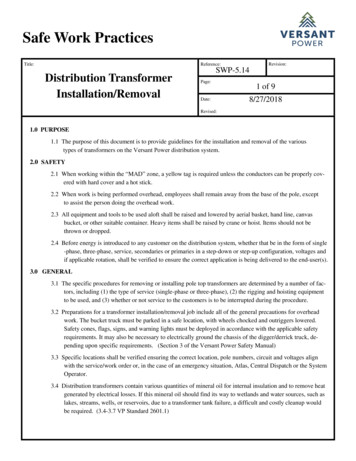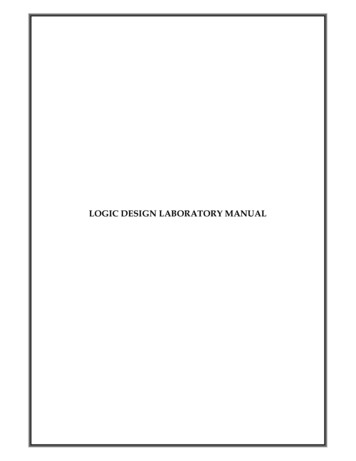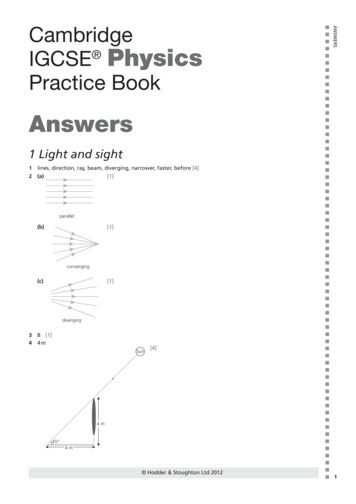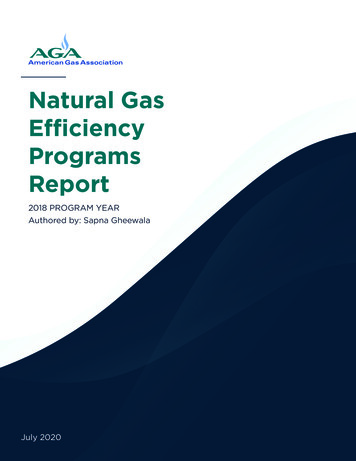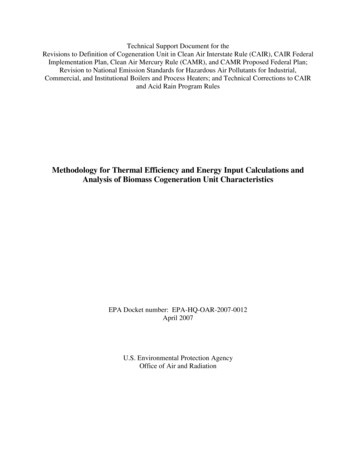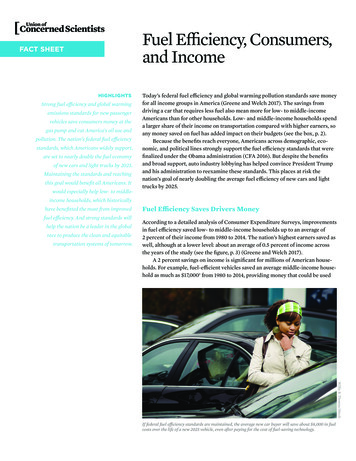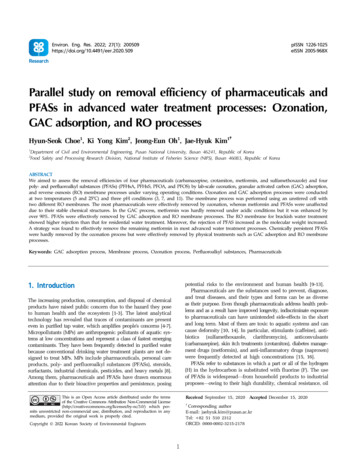
Transcription
pISSN 1226-1025eISSN 2005-968XEnviron. Eng. Res. 2022; 27(1): Parallel study on removal efficiency of pharmaceuticals andPFASs in advanced water treatment processes: Ozonation,GAC adsorption, and RO processesHyun-Seok Choe1, Ki Yong Kim2, Jeong-Eun Oh1, Jae-Hyuk Kim1†1Department of Civil and Environmental Engineering, Pusan National University, Busan 46241, Republic of KoreaFood Safety and Processing Research Division, National Institute of Fisheries Science (NIFS), Busan 46083, Republic of Korea2ABSTRACTWe aimed to assess the removal efficiencies of four pharmaceuticals (carbamazepine, crotamiton, metformin, and sulfamethoxazole) and fourpoly- and perfluoroalkyl substances (PFASs) (PFHxA, PFHxS, PFOA, and PFOS) by lab-scale ozonation, granular activated carbon (GAC) adsorption,and reverse osmosis (RO) membrane processes under varying operating conditions. Ozonation and GAC adsorption processes were conductedat two temperatures (5 and 25 C) and three pH conditions (3, 7, and 11). The membrane process was performed using an unstirred cell withtwo different RO membranes. The most pharmaceuticals were effectively removed by ozonation, whereas metformin and PFASs were unaffecteddue to their stable chemical structures. In the GAC process, metformin was hardly removed under acidic conditions but it was enhanced byover 90%. PFASs were effectively removed by GAC adsorption and RO membrane processes. The RO membrane for brackish water treatmentshowed higher rejection than that for residential water treatment. Moreover, the rejection of PFAS increased as the molecular weight increased.A strategy was found to effectively remove the remaining metformin in most advanced water treatment processes. Chemically persistent PFASswere hardly removed by the ozonation process but were effectively removed by physical treatments such as GAC adsorption and RO membraneprocesses.Keywords: GAC adsorption process, Membrane process, Ozonation process, Perfluoroalkyl substances, Pharmaceuticals1. Introductionpotential risks to the environment and human health [9-13].Pharmaceuticals are the substances used to prevent, diagnose,and treat diseases, and their types and forms can be as diverseas their purpose. Even though pharmaceuticals address health problems and as a result have improved longevity, indiscriminate exposureto pharmaceuticals can have unintended side-effects in the shortand long term. Most of them are toxic to aquatic systems and cancause deformity [10, 14]. In particular, stimulants (caffeine), antibiotics (sulfamethoxazole, clarithromycin), anticonvulsants(carbamazepine), skin itch treatments (crotamiton), diabetes management drugs (metformin), and anti-inflammatory drugs (naproxen)were frequently detected at high concentrations [15, 16].PFASs refer to substances in which a part or all of the hydrogen(H) in the hydrocarbon is substituted with fluorine (F). The useof PFASs is widespread—from household products to industrialproposes—owing to their high durability, chemical resistance, oilThe increasing production, consumption, and disposal of chemicalproducts have raised public concern due to the hazard they poseto human health and the ecosystem [1-3]. The latest analyticaltechnology has revealed that traces of contaminants are presenteven in purified tap water, which amplifies people's concerns [4-7].Micropollutants (MPs) are anthropogenic pollutants of aquatic systems at low concentrations and represent a class of fastest emergingcontaminants. They have been frequently detected in purified waterbecause conventional drinking water treatment plants are not designed to treat MPs. MPs include pharmaceuticals, personal careproducts, poly- and perfluoroalkyl substances (PFASs), steroids,surfactants, industrial chemicals, pesticides, and heavy metals [8].Among them, pharmaceuticals and PFASs have drawn enormousattention due to their bioactive properties and persistence, posingReceived September 15, 2020 Accepted December 15, 2020This is an Open Access article distributed under the termsof the Creative Commons Attribution Non-Commercial 3.0/) which permits unrestricted non-commercial use, distribution, and reproduction in anymedium, provided the original work is properly cited.†Corresponding authorE-mail: jaehyuk.kim@pusan.ac.krTel: 82 51 510 2312ORCID: 0000-0002-3215-2178Copyright 2022 Korean Society of Environmental Engineers1
Hyun-Seok Choe et al.(MF), and sulfamethoxazole (SMZ)) were purchased fromSigma-Aldrich (St. Louis, MO, USA). Two isotope-labeled pharmaceuticals (metformin-d6, sulfamethoxazole-13C6) were purchasedfrom Sigma-Aldrich and used as internal standards. Milli-Q waterand organic solvents that were used for the analysis of the targetcompounds such as methyl alcohol, acetone, and acetonitrile werepurchased from J.T. Baker's (Phillipsburg, NJ, USA); HPLC gradeor higher reagents were used. Potassium indigo trisulfonate, phosphoric acid, and sodium thiosulfate (Na2S2O3) were obtained fromSigma-Aldrich. All chemicals were used as received.resistance, and lubricity induced by strong C-F bonds [17]. However,these properties result in severe persistence, and when they leakinto the ecosystem and body, they rarely dissolve [11, 13].Accordingly, many countries have restricted the use of PFASs suchas perfluorooctanoic acid (PFOA) and perfluorooctanesulfonic acid(PFOS) but other PFAS derivatives such as perfluorohexanoic acid(PFHxA) and perfluorohexanesulfonic acid (PFHxS) are still widelyused and detected in aquatic systems [4, 16, 18]. In particular,in 2018, there were cases in which PFASs were detected in wastewater, treated water, water treatment plants, and tap water; thishas, thus, become a social issue [5].Thus, improved technologies are required to effectively treatsuch MPs, particularly for pharmaceuticals and PFASs. Advancedwater treatment processes are physical/chemical treatment processes that can effectively remove these chemicals from water. Somestudies reported the treatment of the pharmaceuticals by ozonation[19, 20], GAC adsorption [21, 22], and NF/RO membrane processes[23]. There are also studies that reported the treatment of PFASsby ozonation [24, 25], GAC adsorption [26], and NF/RO membraneprocesses [27, 28]. Furthermore, Appleman et al. and Flores etal. reported the treatment of PFASs in American and Spanish watertreatment plants that adopted conventional and advanced watertreatment processes, respectively [29, 30]. However, the pollutantshave been detected even in drinking water treatment plants equipped with such methods. In addition, studies that comprehensivelyanalyze their removal efficiency according to the operating conditions such as temperature and pH are still incomplete. Moreover,it has been rarely reported that studies compare the treatmentefficiency of pollutants by a major advanced water treatment processtargeting the same MPs in parallel in a single paper and examinethe possibility of mutually complementing the removal efficiencyaccording to the process. Herein, we examined the removal efficiencies of the four most frequently detected pharmaceuticals(carbamazepine, crotamiton, metformin, and sulfamethoxazole)and PFASs (PFHxA, PFHxS, PFOA, and PFOS) in parallel bylab-scale advanced water treatment processes-ozone oxidation,granular activated carbon (GAC) adsorption, and reverse osmosis(RO) membrane processes by varying two major operating conditions: pH and temperature. The physicochemical properties ofthe target chemicals, such as pKa, logKOW, and molecular geometrywere also correlated with the removal efficiencies. We believe thatour findings can help to optimize the removal efficiency of MPsthrough an appropriate combination of advanced water treatmentprocesses in the future.2.2. Ozonation ProcessAn ozone generator (Triogen LAB2B, Scotland) was used to generatean ozone stock solution by passing pure oxygen gas (KOSEM, SouthKorea) and bubbling the ozone-containing gas into 1 L of deionized(DI) water chilled using an ice-bath. The absorbance of a mixtureof indigo blue solution at 600 nm was measured to determinethe concentration of ozone stock solution using a spectrophotometer(Optizen POP, South Korea); the concentration was calculated usingthe following equation [31]. The concentration of the ozone stocksolution was determined by the Eq. (1) measuring the absorbanceof the mixture of indigo blue solution at 600 nm.(1)ADIL, AOZONE, f, and b denote the absorbance of the diluted solution,absorbance of ozone stock added solution, indigo blue solutionsensitivity coefficient (0.42), and path length of the cell (cm),respectively. Indigo blue solution was prepared by mixing 1 mLof phosphoric acid, 770 mg of potassium indigo trisulfonate, andfilled up with DI water to 1 L. The prepared indigo blue solutionwas stored in a dark and used within a month. The reaction wasconducted in a 30 mL batch reactor under gentle stirring. The experiments were carried out with mixture of pharmaceuticals and mixtureof PFASs, respectively. The concentrations of each target compoundwere 100 ng/mL. The ozone stock solution was spiked into theozonation reactor to a concentration of 1 mg/L. The reaction lasted3 min, after which sodium thiosulfate and an ozone scavenger wereadded to the sample to remove the residual ozone. Then, the concentrations of the target material were analyzed by liquid chromatography-mass spectrometry (LC-MS). Additionally, 1 M HCl and 1M NaOH were used to adjust the pH to 3 and 11.2.3. GAC Adsorption ProcessThe GAC used during the experiments was Filtrasorb 400 (CalgonCarbon Corporation, Belgium), a highly active granular mesoporouscarbon for removing dissolved organic compounds during the watertreatment process. The GAC was sonicated until the black powderwas removed. GAC adsorption experiments were carried out upflowin a 1 cm-diameter double-walled glass column packed with atotal bed volume of 0.36 mL of GAC (1.80 g in weight). The remainingspace was filled with glass beads. The GAC system was operatedat an empty bed contact time of 100 s and flow rate of 0.6 mLmin-1. Samples were collected 90 min after the start of theexperiments. The concentrations of target compounds were analyzed2. Materials and Methods2.1. Chemical and MaterialsPFASs (PFHxA, PFHxS, PFOA, and PFOS) were purchased fromWellington Laboratories (Guelph, Canada). Four isotope-labeledcompounds (sodiumperfluoro-1-hexane[18O2]sulfonate, sodiumperfluoro1-[1,2,3,4-13C4]octane sulfonate, perfluoro-n-[1,2-13C2]hexanoicacid, perfluoro-n-[1,2,3,4-13C4]octanoic acid) were purchased fromWellington Laboratories and used as internal standards. Four pharmaceuticals (carbamazepine (CBZ), crotamiton (CTM), metformin2
Environmental Engineering Research 27(1) 2005093. Results and Discussion3.1. Treatment Efficiencies of Target Compounds by OzonationThe removal efficiencies of target compounds by the ozonationprocess are shown in Fig. 2. The experiments were carried outat two different temperatures (5 C and 25 C) to simulate watertreatment plants in winter and summer. In addition, the effectof hydrogen peroxide (H2O2), which is known to enhance ozonation efficiency, was evaluated. It was found that CBZ, CTM,and SMZ were fully eliminated ( 99%) within 10 s of reaction,whereas MF and all PFASs showed significantly lower removalefficiencies. This is thought to be due to the chemically stablestructure of MF and PFASs. In particular, PFASs have extremelyhigh thermal and chemical stabilities induced by strong carbon-fluorine bonds. Fluorine is the most powerful electron-withdrawing element; as such, electron-withdrawing groups (e.g.fluorine, -COOH, and -SO3H) depress the reactivity of ozone[33]. Thus, PFASs, which have strong carbon-fluorine bondstogether with electron-withdrawing functional groups, are resistant to strong oxidants such as ozone [1]. On the other hand,the change in removal efficiencies according to the reactiontemperature or the addition of H2O2 was found to be insignificant.This indicates that the treatment efficiencies of target compounds by oxidation are mainly affected by the chemical stabilityof the target materials rather than the change in reactionconditions.Removal efficiencies of target compounds in the ozonation process according to acidic (pH 3), neutral (pH 7), and basic (pH 11)conditions are shown in Fig. 3. Pharmaceuticals such as CBZ,CTM, and SMZ were effectively removed both under acidic andneutral conditions, whereas removal efficiencies at basic conditionssignificantly decreased to less than 20%. This is because hydroxylions (OH-) under basic conditions radically reacted with the ozoneby a series of chain reactions, thus, ozone was rapidly consumedat the initial stage (Eq. (2)). Although hydroxyl radicals (OH·)—morepowerful oxidants than ozone—were generated during this step(Eq. (3)), they are extremely unstable and short-lived in water.Therefore, the generated hydroxyl radicals only reacted with theneighboring elements and immediately disappear [34].Furthermore, the initial concentration of the target compoundswas very low (100 ng/mL) and the generated hydroxyl radicalscould not react sufficiently with the pollutants. In other words,even though hydroxyl radials are more oxidative than ozone, theyare unsuitable for the ozonation process due to their extremelyshort lifetime.Fig. 1. Schematic of advanced water treatment processes and targetmicropollutants.by LC-MS. Each target compound was spiked with DI water toa concentration of 100 ng/mL; 1 M HCl and 1 M NaOH were usedto adjust the pH to 3 and 11.2.4. RO membrane ProcessThe filtration experiments were carried out in a stainless-steel cell(HP4750, Sterlitech, USA) at a volume of 300 mL. Two commercialRO membranes were used in the experiments: TW 80 for householdwater treatment and BW ES for brackish water treatment weresupplied by LG water solutions (South Korea). Membrane couponswere cut with an effective membrane area of 19.6 cm2. Beforebeing loaded into the filtration cell, the membranes were fullyrinsed with DI water and then soaked in DI water for over24 h. The experiments were conducted with mixture of pharmaceuticals and mixture of PFASs, respectively; the feed concentrations of each target compound were 100 ng/mL. The pressurewas applied with pure nitrogen gas to 8 bar at 25 C. Sampleswere collected 10 min after the start of the experiments and analyzedby LC-MS.2.5. Analytical MethodsThe concentrations of PFASs and pharmaceuticals in the extractswere determined using an Agilent 1200 HPLC system coupled toan Agilent 6460 electrospray triple-quadrupole mass spectrometer(Agilent Technologies, Santa Clara, CA, USA) using a method described in previous publications [32]. A binary mobile phase gradient was used and the relevant compounds were identified andquantified using multiple reaction monitoring methods. The HPLCsystem was fitted with a guard column (4.6 mm id, 12.5 mm long,5 μm particle diameter; Agilent Technologies) and a ZORBAX XDBC18 HPLC column (4.6 mm id, 150 mm long, 3.5 μm particle diameter; Agilent Technologies). Detailed analytical conditions and conditions used to quantify pharmaceuticals and PFASs are referredto in previous research [32].(2)(3)Meanwhile, MF and PFASs were hardly removed during theozonation processes regardless of pH. As PFASs have antioxidantproperties for various processes such as oxidation, ozone/H2O2,ozone/UV, and ozone/TiO2 processes, it is unsuitable to treat PFASsthrough chemical oxidation processes [24, 25].3
Hyun-Seok Choe et al.decreases with an increase in temperature [36, 37]. In this study,however, the removal efficiency of MF was improved with an increase in temperature. This phenomenon is thought to be dueto the activation of new adsorption sites and accelerated movementof MF molecules at high temperatures [38].The removal efficiencies of target compounds in the GAC adsorption process according to acidic (pH 3), neutral (pH 7), and basic(pH 11) conditions were also assessed (Fig. 5). The treatment efficiencies of all the tested PFASs and pharmaceuticals except MF remainedlargely unaffected by variations in pH. Interestingly, the low treatment efficiency of MF at lower pH ( 10% at pH 3) increasedas the pH increased and reached more than 95% at pH 11. Thismay be because the hydrophobicity of MF dramatically changedalong with pH. As depicted in Fig. 6, MF has two pKa values(2.8 and 11.5). Between acidic and neutral pH, MF molecules havea positive charge due to the protonated form of amine groups,making them hydrophilic under these conditions. As pH approachespKa2(11.5), the deprotonated form of MF becomes dominant, thus,the molecule develops hydrophobic characteristics. ConsideringFig. 2. Effects of temperature and H2O2 on the removal rates of pharmaceuticals and PFASs from ozonation process.Fig. 3. Effects of pH on the removal rates of pharmaceuticals and PFASsfrom ozonation process.Fig. 4. Effects of temperature on the removal rates of pharmaceuticalsand PFASs from GAC adsorption process.3.2. Treatment Efficiencies of Target Compounds by theGAC Adsorption ProcessRemoval efficiencies of target compounds in the GAC adsorptionprocesses at temperatures of 5 C and 25 C are shown in Fig. 4,assuming that these are the winter and summer temperatures ofwater treatment plants, respectively. Not only pharmaceuticals including CBZ, CTM, and SMZ, but also PFASs, which were rarelyremoved in the ozonation process, were effectively treated ( 99.5%)by the GAC adsorption processes. The effect of temperature wasinsignificant. MF remained unaffected after the GAC process, whichis thought to be due to the extremely high hydrophilicity of MF(log KOW -2.64 at pH 7), as shown in Table 1. GAC is a porousmaterial with a hydrophobic surface and high adsorption rate forhydrophobic materials, whereas selective physical adsorption occurs for a hydrophilic material, thereby decreasing the adsorptionrate [35]. The low removal efficiency of MF by the GAC processimproved to 30% at 25 C. In general, the adsorption reaction isconsidered to be an exothermic reaction and the adsorption capacityFig. 5. Effects of pH on the removal rates of pharmaceuticals and PFASsfrom GAC adsorption process.4
Environmental Engineering Research 27(1) 200509Table 1. Physicochemical Properties of The Pharmaceuticals and PFASsCompoundsEmpirical formula M.W.pKaLog (KOW)Carbamazepine (CBZ)C15H12N2O236.313.92.45Crotamiton (CTM)C13H17NO203.3-0.62.73*C4H11N5129.2pKa1: 2.8,pKa2:11.5-2.64*C10H11N3O3S253.3pKa1: 1.6,pKa2: 5.70.89Perfluorohexanoic acid nic acid (PFHxS)C6HF13O3S400.10.143.16*Perfluorooctanoic acid (PFOA)C8HF15O2414.12.56.3Perfluorooctanesulfonic acid (PFOS)C8HF17O3S500.1-3.36.28Metformin (MF)Sulfamethoxazole (SMZ)*: estimated valueess is shown in Fig. 7(a). Two RO membranes (TW 80 and BWES) were used in this study: TW 80 membrane was designed totreat tap water which contains a low concentration of impurities,whereas BW ES membrane was designed to treat brackish waterwhich contains much higher concentration of salts and pollutants.The experimenting pressure of 8 bars followed the average operatingpressure of the household RO membrane. BW ES showed higherrejection rates compared to TW 80 under the same operating pressurefor all target compounds, indicating that BW ES has a denser skinlayer than TW 80. It is also consistent with the fact that BW ESprovides higher NaCl rejection (99.6%) than TW 80 (98%), as provided by the manufacturer.The rejection rates of MF with the small molecular weight ( 130Da) and highly hydrophilic properties (log KOW -2.64 at pH 7)were found to be remarkably low ( 10%). However, other pharmaceuticals (CBZ, CTM, SMZ) showed a far higher rejection( 99%) compared to PFASs (60 90%). This is an interesting resultFig. 6. Protonation of metformin molecule according to pH change.that ozonation failed to remove MF, pH control could be a strategyto improve the removal rate of MF by a simple method in theGAC process.3.3. Treatment Efficiencies of Target Compounds by ROMembrane ProcessRejection of pharmaceuticals and PFASs in the RO membrane proc-5
Hyun-Seok Choe et al.MF and PFASs were unaffected, regardless of the temperature.Under basic conditions, the lifetime of ozone and treatment efficiency decreased. MF and PFASs were evaluated to have low treatment efficiency by ozone oxidation, regardless of temperature andpH owing to their chemically stable structures. Not only pharmaceuticals such as CBZ, CTM, and SMZ but also PFASs were effectively removed by the GAC adsorption process regardless of temperature and pH. MF was hardly removed under acidic and neutralconditions. As the pH increased, however, MF lost electric chargeand developed increased hydrophobicity; thus, treatment efficiencywas improved via GAC. In the RO membrane process, at the samepressure, the RO membrane for brackish water showed higher removal efficiencies for all target substances than for the residentialwater. Even in the RO process, MF showed a significant lowrejection ( 10%) due to its small molecular weight and a highhydrophilicity, while other pharmaceuticals had high rejectionrates of 98% or more. PFASs having a one-dimensional molecularstructure exhibited a lower level of rejection than pharmaceuticalsdespite of having a higher molecular weight.This study proved that the GAC adsorption process is very effective for treating extremely persistent PFASs regardless of temperature and pH conditions. Furthermore, it was confirmed that substances such as MF that are not generally treated by ozonationand GAC processes can be treated by adjusting the pH.abAcknowledgementFig. 7. (a) Rejection of pharmaceuticals and PFASs by varying ROmembranes. (b) 3-dimensional molecular size of CTM andPFHxA.This work was supported by a 2-year research grant from PusanNational University.Author Contributionsconsidering the fact that the molecular weight of pharmaceuticals(200 250 Da) is smaller than that of PFASs (300 500 Da). Wespeculate that this is due to the difference in the steric partitioningfactors such as molecular length, width, and shape. As shownin Fig. 7(b), CBZ, CTM, and SMZ have two- or three-dimensionalbulky molecular structures, whereas PFASs have a one-dimensionallinear structure. Thereby, PFASs could pass through the RO membrane in the longitudinal direction, while the pharmaceuticals wereblocked due to their bulky structure. Similar results have beenalso reported in other studies [39-41]. On the other hand, in comparison to the PFASs, it was clearly observed that the rejection wasincreased as the molecular weight was increased, implying thatan overall molecular size is still important in the PFASs rejection.The above results show that there is a limit to predict the rejectionof pollutants by the RO membrane simply considering molecularweight, thereby molecular geometry must be considered.H.S.C. (Ph. D. student) conducted the target compounds removalexperiments and wrote the manuscript. K.Y.K. (Researcher) conducted the analytical experiments and wrote the manuscript. J.E.O.(Professor) revised the manuscript. J.H.K. (Associate Professor)wrote and revised the manuscript.References1. Kümmerer K. The presence of pharmaceuticals in the environment due to human use-present knowledge and futurechallenges. J. Environ. Manage. 2009;90:2354-2366.2. Neale PA, Ait-Aissa S, Brack W, et al. Linking in vitro effectsand detected organic micropollutants in surface water usingmixture-toxicity modeling. Environ. Sci. Technol. 2015;49:14614-14624.3. Shao Y, Chen Z, Hollert H, Zhou S, Deutschmann B, SeilerTB. Toxicity of 10 organic micropollutants and their mixture:Implications for aquatic risk assessment. Sci. Total Environ.2019;666:1273-1282.4. Rahman MF, Peldszus S, Anderson WB. Behaviour and fateof perfluoroalkyl and polyfluoroalkyl substances (PFASs) indrinking water treatment: A review. Water Res. 2014;50:318-340.4. ConclusionsIn this study, the treatment efficiencies of four pharmaceuticalsand four PFASs that are frequently detected in the water systemswere assessed by three advanced water treatment processes: ozonation, GAC adsorption, and RO membrane processes. CBZ, CTM,and SMZ were effectively treated by the ozonation process, whereas6
Environmental Engineering Research 27(1) 200509ozonation at a municipal sewage treatment plant. Water Res.2007;41:4373-4382.20. Alharbi SK, Price WE, Kang J, Fujioka T, Nghiem LD. Ozonationof carbamazepine, diclofenac, sulfamethoxazole and trimethoprim and formation of major oxidation products. Desalin. WaterTreat. 2016;57:1-12.21. Yu Z, Peldszus S, Huck PM. Adsorption characteristics of selected pharmaceuticals and an endocrine disrupting compound—Naproxen, carbamazepine and nonylphenol—on activatedcarbon. Water Res. 2008;42:2873-2882.22. Qiao T, Yu Z, Zhang X, Au DWT. Occurrence and fate of pharmaceuticals and personal care products in drinking water in southern China. J. Environ. Monit. 2011;13:3097-3103.23. Phadunghus K, Wongrueng A, Rakruam P, Wattanachira S,Punyapalakul P. Efficiencies of NF and RO membranes on pharmaceutical removal and membrane fouling effects. Eng. J.2017;21:101-112.24. Schröder HF, Meesters RJW. Stability of fluorinated surfactantsin advanced oxidation processes—A follow up of degradationproducts using flow injection-mass spectrometry, liquid chromatography-mass spectrometry and liquid chromatography-multiple stage mass spectrometry. J. Chromatogr. A2005;1082:110-119.25. Huang J, Wang X, Pan Z, Li X, Ling Y, Li L. Efficient degradationof perfluorooctanoic acid (PFOA) by photocatalytic ozonation.Chem. Eng. J. 2016;296:329-334.26. Hansen MC, Børresen MH, Schlabach M, Cornelissen G.Sorption of perfluorinated compounds from contaminated waterto activated carbon. J. Soils Sediments. 2010;10:179-185.27. Tang CY, Fu QS, Robertson AP, Criddle CS, Leckie JO. Useof reverse osmosis membranes to remove perfluorooctane sulfonate (pfos) from semiconductor wastewater. Environ. Sci.Technol. 2006;40:7343-7349.28. Tang CY, Fu QS, Criddle CS, Leckie JO. Effect of flux(transmembrane pressure) and membrane properties on foulingand rejection of reverse osmosis and nanofiltration membranestreating perfluorooctane sulfonate containing wastewater.Environ. Sci. Technol. 2007;41:2008-2014.29. Flores C, Ventura F, Martin-Alonso J, Caixach J. Occurrenceof perfluorooctane sulfonate (PFOS) and perfluorooctanoate(PFOA) in N.E. Spanish surface waters and their removal ina drinking water treatment plant that combines conventionaland advanced treatments in parallel lines. Sci. Total Environ.2013;461-462:618-626.30. Appleman T D, Higgins C P, Quiñones O, Vanderford B J, KolstadC, Zeigler-Holady J C, Dickenson E R V. Treatment of polyand perfluoroalkyl substances in U.S. full-scale water treatmentsystems. Water Res. 2014;51:246-255.31. Gordon G, Bubnis B. Residual Ozone Measurement: IndigoSensitivity Coefficient Adjustment. Ozone: Sci. Eng. 2002;24:17-28.32. Kim KY, Ekpe OD, Lee HJ, Oh JE. Perfluoroalkyl substancesand pharmaceuticals removal in full-scale drinking water treatment plants. J. Hazard. Mater. 2020;400:123235.33. von Gunten U. Ozonation of drinking water: Part I. Oxidationkinetics and product formation. Water Res. 2003;37:1443-1467.34. Gardoni D, Vailati A, Canziani R. Decay of Ozone in Water:A Review. Ozone: Sci. Eng. 2012;34:233-242.5. Park H, Choo G, Kim H, Oh JE. Evaluation of the current contamination status of PFASs and OPFRs in South Korean tapwater associated with its origin. Sci. Total Environ. 2018;634:1505-1512.6. Tröger R, Klöckner P, Ahrens L, Wiberg K. Micropollutantsin drinking water from source to tap - Method developmentand application of a multiresidue screening method. Sci. TotalEnviron. 2018;627:1404-1432.7. Kim H, Ekpe OD, Lee JH, Kim DH, Oh JE. Field-scale evaluationof the uptake of Perfluoroalkyl substances from soil by ricein paddy fields in South Korea. Sci. Total Environ. 2019;671:714-721.8. Luo Y, Guo W, Ngo HH, et al. A review on the occurrenceof micropollutants in the aquatic environment and their fateand removal during wastewater treatment. Sci. Total Environ.2014;473-474:619-641.9. Dietrich S, Ploessl F, Bracher F, Laforsch C. Single and combinedtoxicity of pharmaceuticals at environmentally relevant concentrations in Daphnia magna – A multigenerational study.Chemosphere 2010;79:60-66.10. West PR, Weir AM, Smith AM, Donley ELR, Cezar GG. Predictinghuman developmental toxicity of pharmaceuticals using humanembryonic stem cells and metabolomics. Toxicol. Appl.Pharmacol. 2010;247:18-27.11. Borg D, Lund BO, Lindquist NG, Håkansson H. Cumulativehealth risk assessment of 17 perfluoroalkylated and polyfluoroalkylated substances (PFASs) in the Swedish population.Environ. Int. 2013;59:112-123.12. Neale PA, Leusch FDL, Escher BI. Applying mixture toxicitymodelling to predict bacterial bioluminescence inhibition bynon-specifically acting pharmaceuticals and specifically actingantibiotics. Chemosphere 2017;173:387-394.13. Menger F, Pohl J, Ahrens L, Carlsson G, Örn S. Behaviouraleffects and bioconcentration of per- and polyfluoroalkyl substances (PFASs) in zebrafish (Danio rerio) embryos.Chemosphere 2020;245:125573.14. Cizmas L, Sharma VK, Gray CM, McDonald TJ. Pharmaceuticalsand personal care products in waters: occurrence, toxicity, andrisk. Environ. Chem. Lett. 2015;13:381-394.15. de Jesus Gaffney V, Almeida CMM, Rodrigues A, Ferreira E,Benoliel MJ, Cardoso VV. Occurrence of pharmaceuticals ina water supply system and related human health risk assessment.Water Res. 2015;72:199-208.16. Scher DP, Kelly JE, Huset CA, et al. Occurrence of perfluoroalkylsubstances (PFAS) in garden produce at homes with a historyof PFAS-contaminated drinking water. Chemosphere 2018;196:548-555.17. Marchetti N, Guzzinati R, Catani M, Massi A, Pasti L, CavazziniA. New insights into perfluor
water treatment and BW ES for brackish water treatment were supplied by LG water solutions (South Korea). Membrane coupons were cut with an effective membrane area of 19.6 cm2. Before being loaded into the filtration cell, the membranes were fully rinsed with DI water an


